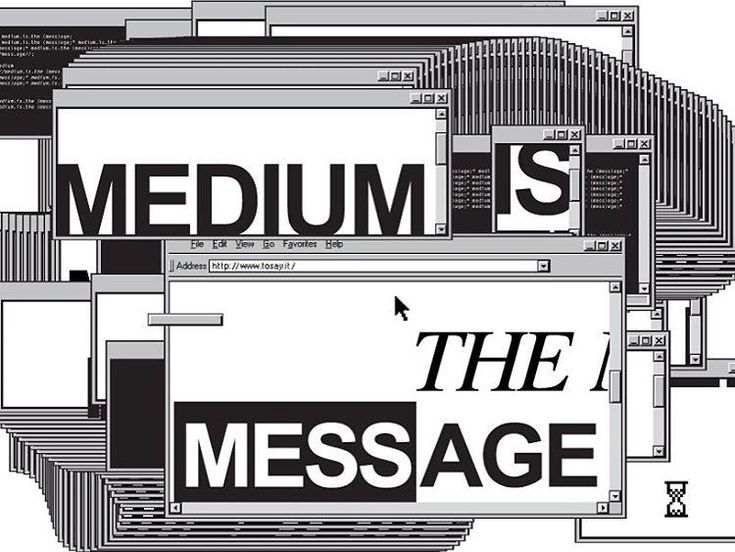I don’t remember how many times I’ve read the first chapter of “Understanding Media” entitled “The Medium is the Message” in order to figure out what Marshall McLuhan meant by his catchphrase. After many years of tinkering this is my interpretation.

Before I get into the author’s key words, a definition of language will be helpful in staging the scope of meaning: Language is any form of communication, verbal and non-verbal, visual or non-visual, between two or multiple participants. It does not only refer to English, French or Spanish or any other spoken or written languages.
The meaning of language evolved with the introduction of computers and the Internet. An updated meaning could be explained by the following example; a user typing letters on a keyboard that activates a software created with codes (another form of language in itself), projecting various commands on a screen to accomplish a task like communicating with oneself by writing, or communicate with another person via email or any other app.
This communication process also applies to message. Namely, any information or directive conveyed by words, spoken or written, or any signs or symbols between a sender and a receiver. For instance, a stop sign sends a message informing a driver to make a stop at an intersection.
Whereas the stop sign is a medium that reverts to a city’s public works department, and it, to another medium in terms of government bureaucrats, and it, to city council and to a mayor… so on and so forth. The content of a medium always refers to an ultimate agent of power and control.
This fact, characteristic of all media, means that the “content” of any medium is always another medium.
Today the word medium is mostly used in its plural form of media. It represents a technological purveyor of content to the masses. Its essential role is to be an intermediary, a broker or a middleman between a provider (as in, owner/producer) and a recipient (as in, minion/consumer).
Mass-media like a movie, a video clip or news, reverts to a lineup of invisible mediums that transcend a TV screen, a monitor, a smart phone or any other device. These mediums hark back to a line-up of other mediums like a camera, sound equipment, a screenplay, actors, editors, etc, until we get to the executive producers and finally to varied global distribution companies which are owned by major global corporations.
Overtime corporate-media developed its own language distinct from a human form of communication. This language is mostly in edited format of re-packaged information. It’s safe to say that whatever is mediated is not the real thing but a representation of a human being, a physical thing or a real event. It’s a facsimile. It’s a make believe it’s a real thing.
Since the introduction of mass-media, advertising has taken a bigger role in how language is used in culture, in politics and in the economy by being inserted in every story, news, message or content, blurring the boundaries between what is a real being/event/thing and what is the language of advertising.
Several years ago I gave a radio interview. The host asked me what was my interpretation of McLuhan’s saying? I replied: “who owns the medium owns the message”. My answer sparked a dead silence on the part of the host. Then and there it dawned on me that you don’t bite the advertising hand that feeds you. Somehow I kissed goodbye to my popularity rank.
The content of a medium always reverts to an ultimate agent of power and control.
Over the decades, global corporation with the help of mass-media, have consolidated their power over culture, politics and the economy. McLuhan explains.
The fact merely underlines the point that “the medium is the message” because it is the medium that shapes and controls the scale and form of human association and action.
For-profit and non-profit corporations all have a similar legal definition. They all use the same accounting practices. Whereas for-profit moneyed corporations have an additional goal to be profitable.
Because trans-national corporations share the same accounting practices, goal and doctrine, their common structure favored an implicit alliance. In time corporations morphed into ONE subliminal global body. An example is the Investor-State Dispute Settlement (ISDS) whose purpose is to set up a court system where corporations can sue countries for discriminatory practices. Through the years the global body remained inconspicuous and hidden from public view, because like Michel Foucault pointed out, power is the most efficient when it’s invisible.
The language of advertising has over time spread Global-Inc’s subliminal message in varied areas of culture, the economy and politics. Global-Inc’s power and reach has grown to such an extent that it is now challenging the sovereignty of nations-states of the world, including the United States of America.
This is evidenced by directives issued by non-elected officials in the global arena and in the US government that favored Global Big Tech’s take over of market share previously in the hands of players in the local economy; namely, mom and pop shops, small and medium size businesses, local bars and the gig economy, small and large music concert venues, minor and major league sports events and the tourist industries.
For instance, Big Tech’s imposing their own gag rules on citizens by implementing denial of service that undermines free speech while simultaneously encroaching on the First Amendment of the United States’ Constitution.
The subversion of the sovereignty of the States and of individuals has permeated varied national security branches of the federal government. Some branches are contemplating making any dissent or protest against a perceived violation the US Constitution a crime and potentially making a citizen a “domestic terrorist”.


